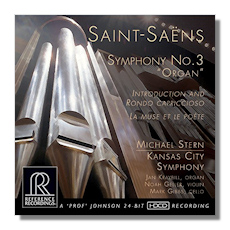
The Internet's Premier Classical Music Source
Related Links
- Saint-Saëns Reviews
- Latest Reviews
- More Reviews
-
By Composer
-
Collections
DVD & Blu-ray
Books
Concert Reviews
Articles/Interviews
Software
Audio
Search Amazon
Recommended Links
Site News
 CD Review
CD Review
Camille Saint-Saëns

- Introduction & Rondo Capriccioso in A minor for Violin & Orchestra, Op. 28 1
- La muse et le poéte for Violin, Cello & Orchestra, Op. 132 1,2
- Symphony #3 In C minor, Op. 78 "Organ" 3
1 Noah Geller, violin
2 Mark Gibbs, cello
3 Jan Kraybill, organ
Kansas City Symphony/Michael Stern
Reference Recordings RR-136 61:24 HDCD
Are we having fun yet? This is yet another fantastic disc. The Kansas City Symphony is one of America's finest ensembles, though rarely is that mentioned. And Michael Stern is one of America's finest conductors, though nobody mentions that either. Having never met the man, I can't even imagine what's more irritating, the fact that he stands in his father Isaac's shadow, or that most of the music world has seemingly forgotten his father, too. Not that there's any question of musical talent; having carved out a distinguished career for himself, Stern the Younger continues to gift the market with award-winning releases.
In some ways, this reminds me of Leonard Slatkin's recent Naxos disc from Lyon, in that it puts a substantial and little-known work between two favorites. While Slatkin featured the history of the symphonic organ, Stern gives his excellent first-desk soloists a chance to shine. The Introduction and Rondo Capriccioso sparkles here, and in outstanding sound. Concertmaster Geller is joined by Principal Cellist Mark Gibbs for La muse et le poéte, a concerted work that's completely new to me. Like most of Saint-Saëns, it's rather conservative in nature, but wholly tuneful and very charming. I imagine most listeners will be pleased.
The "Organ" Symphony seems to be a favorite on disc right now. Naxos has already released two fine versions in 2015, but neither sounds quite this good. This is not a work that functions as a mere audiophile showpiece; if it's bad, it's really bad. Happily, Michael Stern chooses a tempo to open the work which ensures that nothing runs together, and he also shapes the music with uncommon attention to detail. Every crescendo is so well-caught that the drama is naturally heightened. The orchestra plays with total commitment and real power. The slower speeds never turn dull because so much energy is invested in every note. If you think that you don't care about the inner movements, check out the fabulous richness of the strings that open the Poco adagio, or the sheer accuracy of the third movement. But you aren't reading this for the inner movements. You want to know how the fabled Reference Recordings sound handles the Finale, right?
The experience is spectacular regardless of equipment. I've listened in a number of different ways already, and the overall effect is spine-tingling. The Kansas City Symphony contributes in a wholly positive way, refusing to be drowned by the formidable organ at the Kauffman Center for the Performing Arts. Jan Kraybill knows the instrument better than anyone, and her previous solo effort for Reference Recordings proved she's an excellent stewardess of the organ she takes care of. I won't spoil your listening with tiny details, but the closing pages are simply a joy. I'm not throwing away legendary versions under Paray, Munch, or Martinon, but I am certainly making room on my shelf for this thrilling sonic and musical experience.
Copyright © 2015, Brian Wigman





















